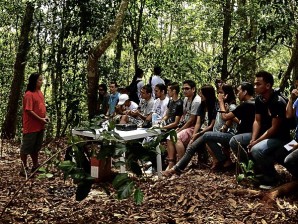Lessons in rare wildlife while reforesting Cebu

WILDLIFE biologist Philip Godfrey Jakosalem gives a talk on bird watching to a group of environmental enthusiasts during the kickoff of the annual reforestation caravan of the Philippine Business for Social Progress on June 23 at Barangay Tabunan in Cebu City. CRIS EVERT LATO
CEBU CITY—Librarian Lorna Eguia was all ears when wildlife biologist Lisa Paguntalan talked about the Cebu Flowerpecker (Dicaeum quadricolor), the never-been-photographed bird found only in Cebu.
“I never knew that we have a rare treasure in the mountains of Cebu. This is a different learning experience, far from the tall buildings rising in the city,” said Eguia, American corner librarian of the University of San Carlos.
She was one of nearly 1,000 people from different companies and organizations who joined the kickoff event of the yearly reforestation caravan of the Philippine Business for Social Progress (PBSP) on June 23 in Sitio Cantipla, Barangay Tabunan, in Cebu City.
Tabunan, a mountain village about 45 minutes by car from the city center, is part of the Central Cebu Protected Landscape (CCPL), Metro Cebu’s primary source of water with an area of more than 28,000 hectares of forests and farmland.
Cebu Hillylands
Article continues after this advertisementThe Cebu Flowerpecker is one of at least 51 bird species found in the Tabunan Forest Corridor inside the CCPL, which is also called Cebu Hillylands.
Article continues after this advertisementKnown as “manuto” to locals, the elusive bird is among the world’s 10 rarest birds and top 50 critically endangered species in the world, according to the International Union for Conservation of Nature and BirdLife International. It was believed to be extinct until it was discovered in 1992 in the Tabunan Forest Corridor.
“Rediscovering the Cebu Flowerpecker adds value to the conservation of Cebu’s less known species. It carries the banner of conservation for the less known endangered species,” said Paguntalan, director for field operations of the Philippines Biodiversity Conservation Foundation Inc.
Paguntalan, who has practiced wildlife conservation and ornithology since 1996, said this was the second chance for Cebuanos and Filipinos to prevent a natural heritage from extinction.
About 100 Cebu Flowerpeckers could be found in Cebu as of 2006-2007, she said. They thrived in the forest patches of Dalaguete town, the Nug-as Forest of Alcoy town, the Mount Lantoy Key Conservation Site in Argao town, and the Tabunan Forest Corridor in Cebu City.
“If you spend three days in Tabunan bird watching, you might have that one chance to see a Cebu Flowerpecker. That is, if you are lucky,” she told the Inquirer.
Birds live in tall native trees, their natural habitat, according to forester Orlyn Roxas. For instance, she said, the Cebu Flowerpecker lives on tall, canopy trees, and feeds on mistletoe flower, making them important seed dispersal agents of rainforest plants.
That explains the presence of the Cebu Flowerpecker only in Tabunan, Alcoy and Dalaguete, which have small forest patches.
Native trees
“This is why we emphasize that in tree-planting activities, we should plant native trees such as narra and mabolo. The birds live in these trees so if you cut them, they will leave and look for other places where these trees are found,” Roxas said.
If the birds could not find trees serving as their natural habitat, they could die, affecting the entire food web, she added.
Paguntalan, Roxas and fellow wildlife biologist, Philip Godfrey Jakosalem, led the conservation talks during the PBSP’s reforestation caravan.
They talked during the breakout sessions after the tree planting to emphasize the relevance of the reforestation project to local wildlife. The sessions also introduced the participants to local wildlife that thrives in Cebu Hillylands.
Inquirer Read-Along
The kickoff event also featured the Inquirer Read-Along program, which was attended by 37 children from Sitio Cantipla.
Eguia and student members of Buhilaman Theatre Organization of St. Theresa’s College served as storytellers of environment-themed books.
“This is real learning. As a librarian, I know that books serve as one of the tools in learning. Seeing how things happen in action is the realization of what we read in the books,” Eguia said.
Young entrepreneur Shanna Lopez celebrated her 28th birthday with the children. Lopez, executive vice president of Nexus, provided lunch of chicken and spaghetti, and school supplies.
She and some employees from Nexus planted seedlings of native trees, such as narra and taluto, in Cantipla.
Magic Melt, Shiela Pongan of the Golden Prince Hotel and Nanette Libron of the Cebu Northwinds Hotel also gave meals, snacks and chocolates during the Read-Along.
Children of PBSP employees—Dorie Arianna Melendres, 5, and Andre Jairus Garso, 7—distributed gift packs to the young listeners. The packs consisted of pencil cases, pens, sharpeners, pencils, small towels, chocolates and candies.
“This is a very good experience for children living in the mountain. It makes us appreciate what we have and take care of them,” said Maria Hebie Vianca Romarate, 12.
Romarate’s father, Giovanni Stephen, manages the Cebu City Zoo,
“He would always tell us to take care of the plants and the trees. We should not destroy them because they are the homes of the birds and other animals,” she said.